Part 3: Kailash Kora's
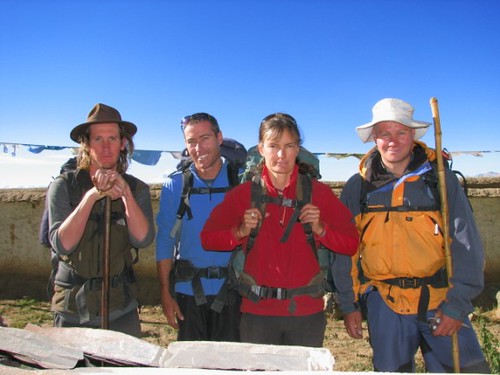 Four friends ready to set off on our first Kora
Four friends ready to set off on our first Kora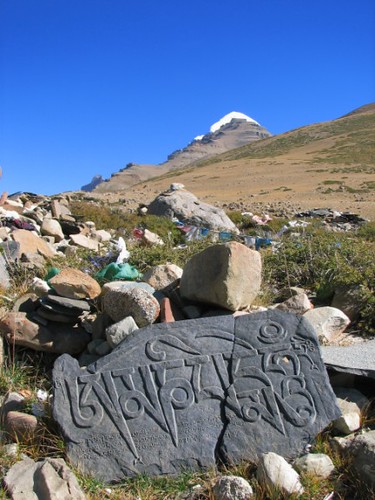 Mani stone at the first prostration point, Kailash in the distance
Mani stone at the first prostration point, Kailash in the distance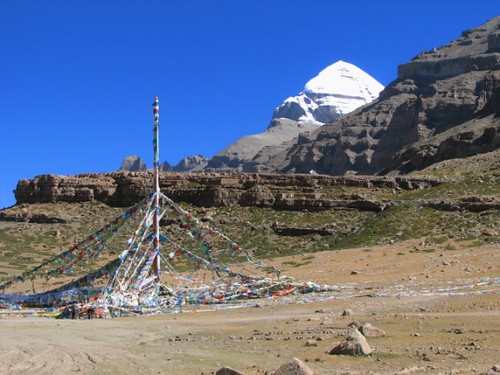 The pole raised each year to celebrate Saka Dawa
The pole raised each year to celebrate Saka Dawa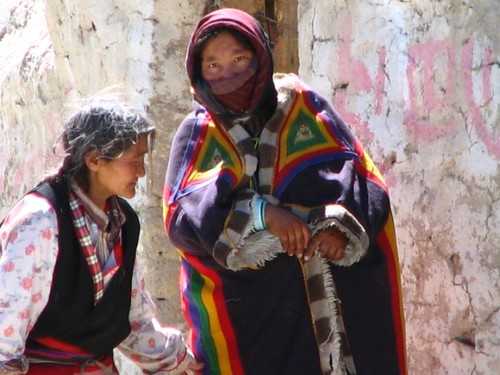
A Tibetan woman and mother near Darchen
The weather was cloudless and stunning - in fact it was largely cloudless with sunny blue skys the entire time we were in the TAR. There were loads of colorful pilgrims on the trail, nomads in family groups mostly, often with babies and young kids at heel. We settled into our own pace and gradually wound our way past the first prostration point and into the mouth of the western valley. This valley has wild rock formations, all with symbolic significance in the Tibetan Tantric world, representing various deities and historical figures.
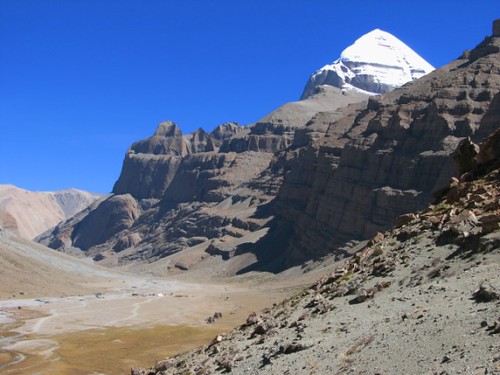 View along the western valley, Guru Rinpoches 'torma' in the background
View along the western valley, Guru Rinpoches 'torma' in the background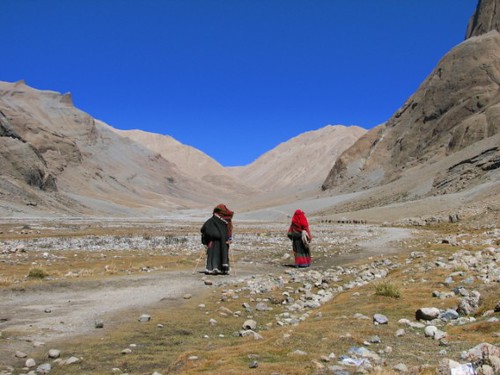 Tibetan pilgrims on the kora trail
Tibetan pilgrims on the kora trail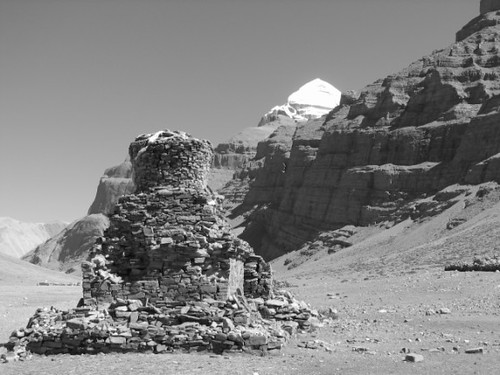 Ancient stupa in the western valley
Ancient stupa in the western valley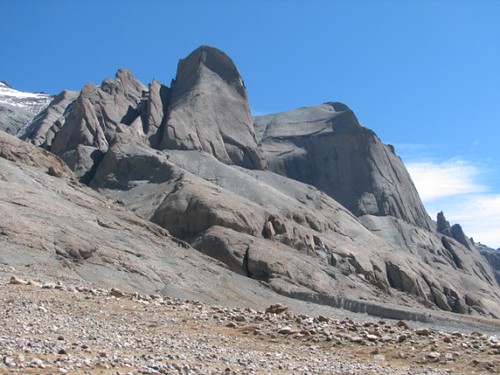 Light on the otherworldly rocks of the western valley
Light on the otherworldly rocks of the western valley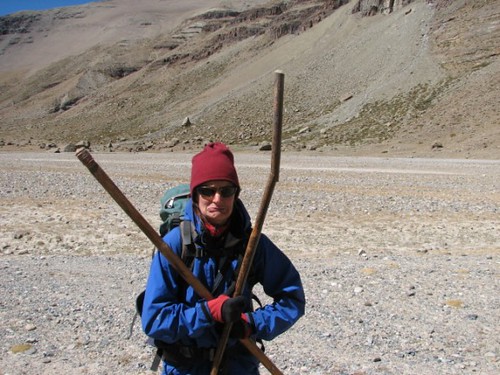 Anna Skywalker challenged the Dark Farter to an impromptu duel in the western valley - and lost. Her light-sabre-stick beyond repair by any force
Anna Skywalker challenged the Dark Farter to an impromptu duel in the western valley - and lost. Her light-sabre-stick beyond repair by any forceOccasional shenanigans on the trail served as light relief, for at this altitude the physical effort of carrying a pack, even with only ~8kgs, makes your lungs and heart work seriously hard. Joe was still being plagued by a persistent gut bug and weakened from the previous day. It was a longish day before we arrived at Drirapuk Gompa, at 5200m. Drirapuk has an incredible location - situated on the side of a hill facing directly towards the magnificent northern face of Kailash.
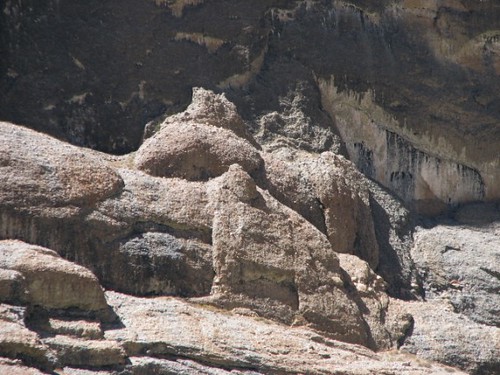 A self manifesting Buddha in the rocks - if you have the karma to see it of course!
A self manifesting Buddha in the rocks - if you have the karma to see it of course!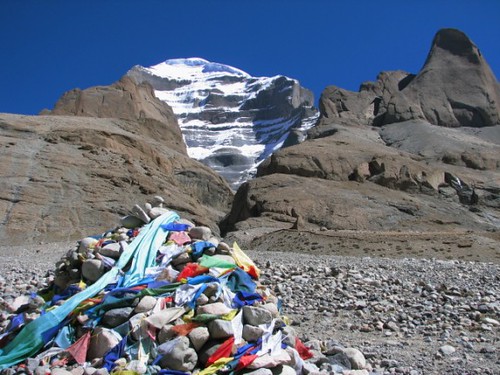 Western face of Mt Kailash
Western face of Mt Kailash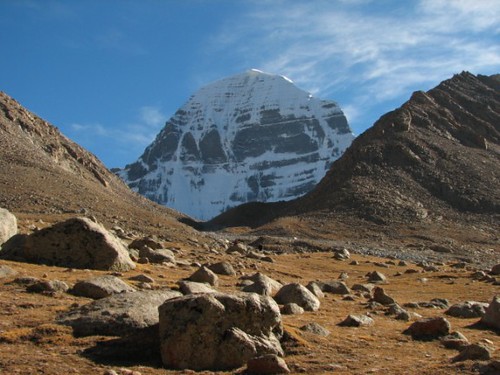
The magical North face of Mt Kailash
Anna had a couple of minor balance and confidence issues arise whilst crossing the rocks of a rather cold stream at Drirapuk. The resultant slippage led to her boots becoming fully submersed in the water. The challenging karma of having wet boots, the day before crossing a major pass, was compounded by the fact that when drying them by a fire that night the inner soles got a tad too hot and performed an irreversible shrinki-dink-shrivel up trick - thus rendering them absolutely useless. No inner soles on the pass for Anna!
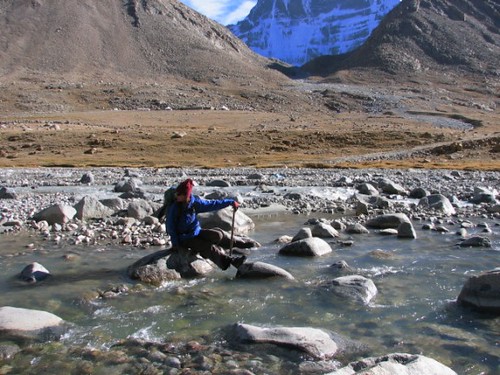 Anna in the drink while crossing the stream to Drirapuk gompa
Anna in the drink while crossing the stream to Drirapuk gompa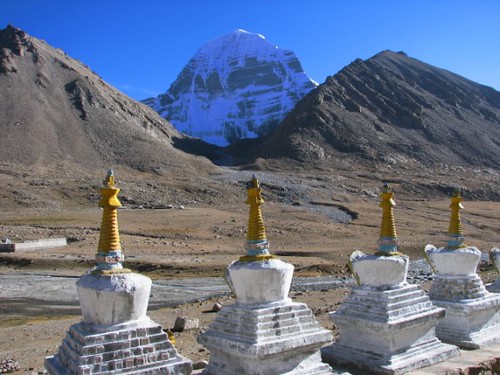 Rows of stupas at Drirapuk Gompa
Rows of stupas at Drirapuk Gompa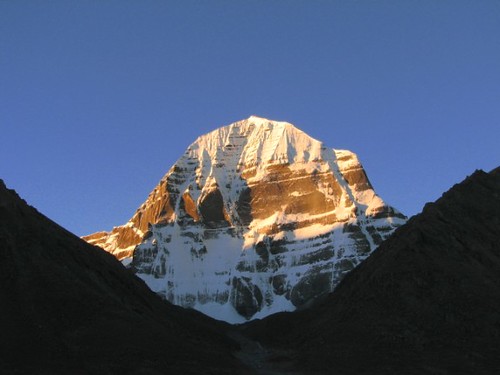
Sunrise on the northern face
We were pretty hungry by the end of the day, having missed lunch, but were informed by the Gompa that there was no food available beyond Tsampa. Too many Tibetan pilgrims were waiting to be fed. This was fair enough, but this turned out to be part of an emerging and ongoing pattern of injies being lied to and treated like crap and charged a bucketload for it. So we settled in for what we could scrounge from our tucker bags and managed to get some hot brews into us before bed - high altitude dreaming.
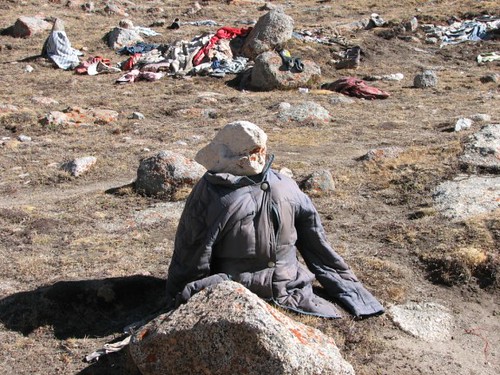 Clothing left behind by Tibetan pilgrims, symbolic of shedding the ego
Clothing left behind by Tibetan pilgrims, symbolic of shedding the ego
Heading up towards the Drolma-la pass, ~5600m
The next morning began with a slow, steady plod up the hill towards the Drolma-la pass at ~5600m. Part of the scenery included many large piles of clothing, some very artfully arranged (!), which had been discarded by Tibetan pilgrims - representing symbolic shedding of the ego. There is one point where you lay down and visualise yourself going through the death process and the body decaying, rotting and withering away into crow gibblets and bleached bones. And then you emerge reborn and renewed. This was good idea and also seemed a pretty strategic spot to rest just before the last steep ascent to the pass!
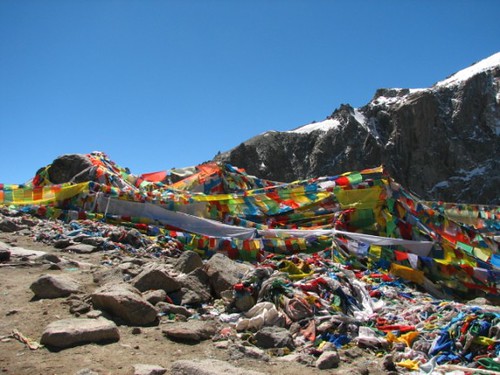 Prayer flags at the Drolma-la pass
Prayer flags at the Drolma-la pass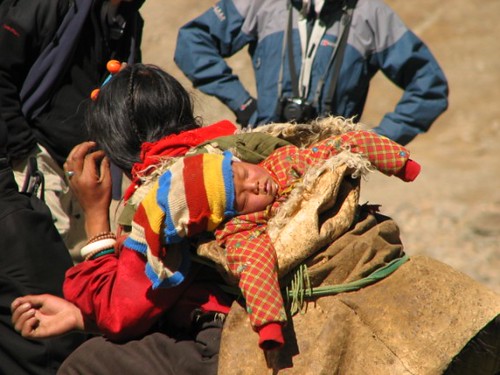
Tibetan woman with baby on her back resting at the Drolma-la
A well deserved rest at the top was followed by a steep descent into the eastern valley, past Buddha footprints in rocks and other significant points. There was a cold headwind wind howling up this valley as we made out way to the next Gompa. Progress felt slow and it was a very long day by the time we arrived. Joe and Mark reached there just on dusk. This Gompa, Zatrulpuk, had a cave that was dedicated to Milarepa, one of Tibets most famous and amazing Yogis. Apparently he meditated here for a while and there are many stories and sites related to him and his various exploits in the eastern valley.
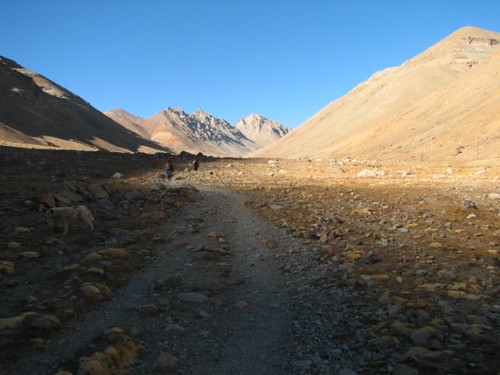 Afternoon shadows in the windy eastern valley
Afternoon shadows in the windy eastern valley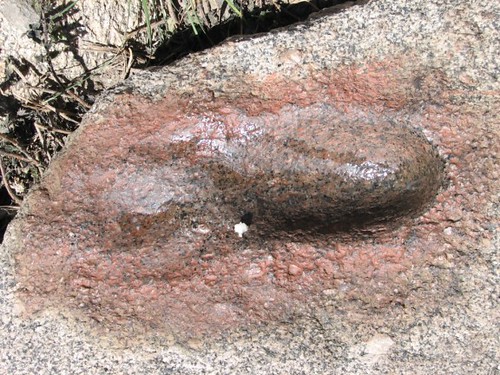 A Buddha footprint (paw-print??) in a rock after the Drolma-la
A Buddha footprint (paw-print??) in a rock after the Drolma-la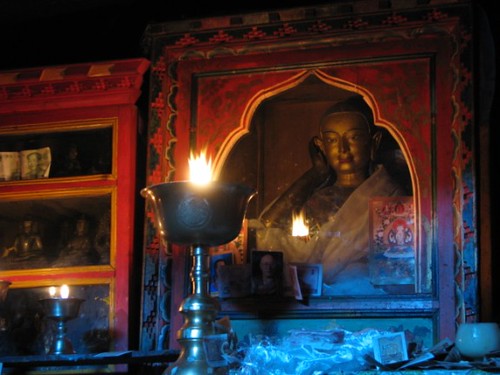 Inside a Milarepa cave at Zatrulpuk gompa in the western valley
Inside a Milarepa cave at Zatrulpuk gompa in the western valley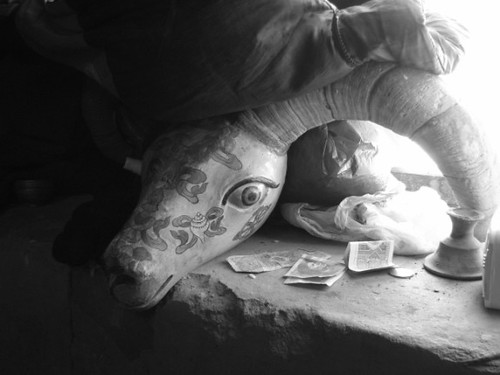
Contemporary western Tibet art object - decorated sheeps skull
It is only a few hours walk from Zatrulpuk to Darchen, so we took plenty of time the following morning to savor our breakfast of Tsampa and rancid-butter-smelling hot water. To be fair i actually really like Tsampa, though the quality varies substantially. Unfortunately it can be really hard on your digestive system (especially when it has finely crushed sand in it - a by-product of the barley roasting process) and can result in copious quantities of gaseous emissions. Particularly when consumed over a prolonged period or in large quantities. I mean a fart or two is fine right, but very, very large ones every few minutes is painfully ridiculous!
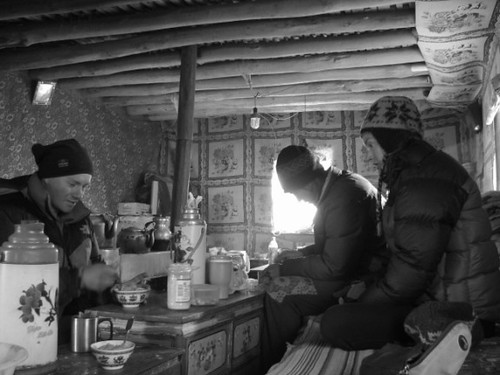 Tsampa again?!! Can you pass the rancid-butter-smelling hot water please?
Tsampa again?!! Can you pass the rancid-butter-smelling hot water please?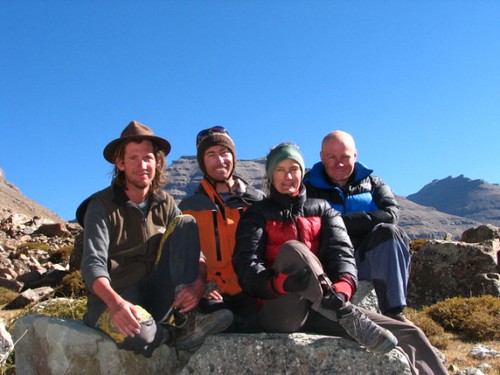 Towards the end of the 1st Kora, weary and happy
Towards the end of the 1st Kora, weary and happy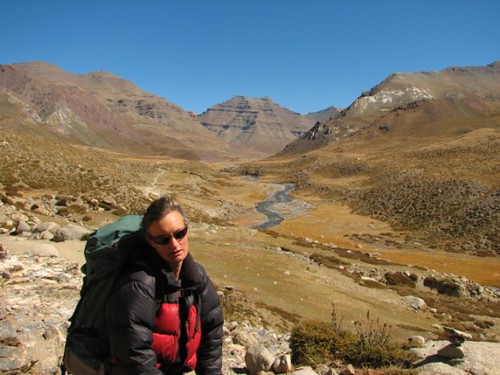
An expression with a million words,...are we there yet?
So, back at Darchen, weary and happy. Ripe for a wash and keen to clean socks that were ready to leap off ones feet and crawl out the door. At this point we realised we had not had a wedding cake yet! So began the process of assembling the ingredients (chocolate drinking powder, nutella, almonds) that had been lovingly carried all the way from Daramsala. A chocolate-tsampa-nutella wedding cake was the result and we all agreed hands down that this was the only way to eat roasted barley flour!
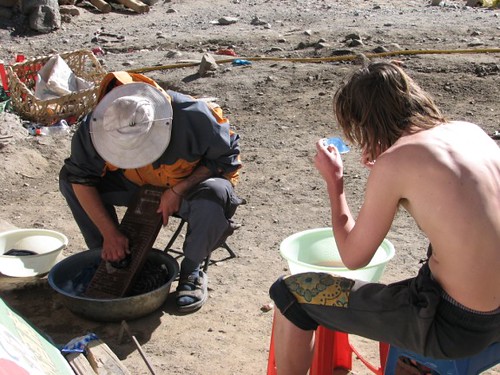 Cleaning up (socks - errrrgh!!) back in Darchen
Cleaning up (socks - errrrgh!!) back in Darchen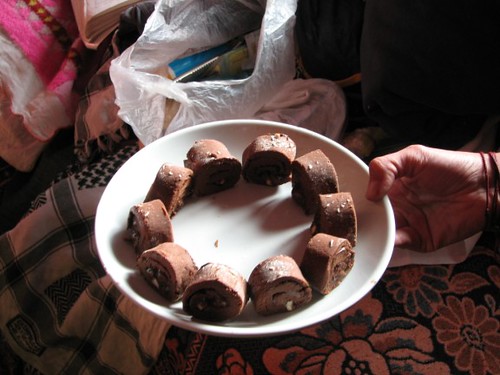
The infamous tsampa-chocolate-nutella wedding cake
Darchen is a strange place. Especially after the silence and beauty of Kora. Rather like an unloved truckstop, only far fouler than any truckstop i have had the fortune to witness. A pit-stop for passing pilgrims. This is the jumping off place for the Kora, one of the most sacred circuits in the whole of Tibet, indeed Asia, and yet Darchen most closely resembles a garbage dump or land-fill, with a bunch of dwellings roughly stacked on top. Stuff strewn everywhere, especially in the stream which flows out of the sacred inner Kora (which also happens to be the towns water supply!). The entire place was loaded with garbage and all manner of discarded plastic crap. But perhaps the most common item of all was smashed beer bottles. Oodles of them. Everywhere shards of green and brown glass poking up out of the earth.
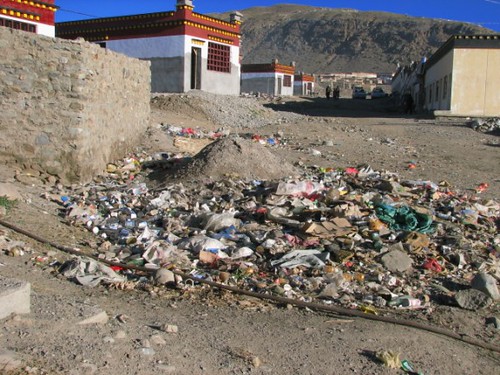
Main street in Darchen - piles of garbage all over the place
Loads of large dogs roamed the streets of Darchen and about 20% had a limp. I wondered about this when i first arrived and finally twigged to what it was - paw injuries from all the broken glass! All this garbage - was it a result of disconnection or lack of education or what?? What about this sacred-earth thing guys?? Is this just my own stupid romantic notion? Eco-friendly nomads or some other one-dimensional concept i was clinging to?
Maybe no one cares here because the bulk of the population is so transient. Possible, but it really is not that hard to dig a large hole and put the trash in hey. No, it does not solve the deeper issue, but contains it and helps with amenity and basic hygiene. This was the source of many head shaking conversations whilst we were there and made going outside rather unpleasant.
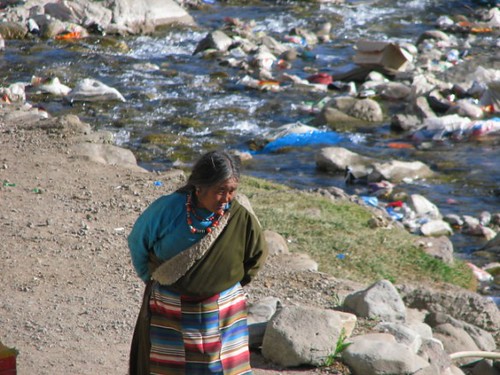 A Tibetan woman with the backdrop of the polluted inner Kora stream as it flows through Darchen
A Tibetan woman with the backdrop of the polluted inner Kora stream as it flows through Darchen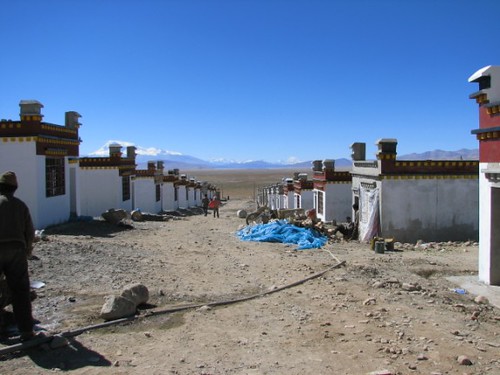 Construction of masses of new accomodation underway at Darchen
Construction of masses of new accomodation underway at Darchen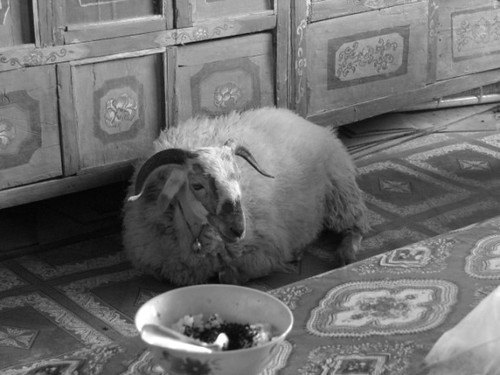
A pet sheep at the Om cafe in Darchen - our favourite hangout
However, another part of Darchen is undergoing a major construction boom. Things are happening in the dust and garbage. Government sponsored accommodation buildings are being built at a rapid rate and given what we saw from hills above the town, this could easily more than double the towns current carrying capacity. Given that the Chinese are intending to build an airport at Ali and are also going gangbusters to tar the road all the way from Ali to Darchen (the first third is already complete), collectively this seems like a recipe for a massive Govt. sponsored tourism expansion. I wonder what they are planning to do with all the extra shit and garbage then?
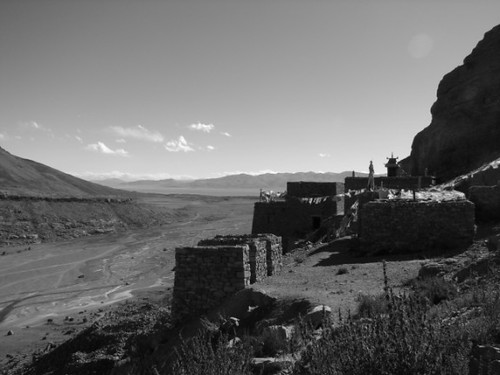
Nyenri gompa nestled in the side of a hill
At this point in the journey the group of four dissolved a natural dissolution. Mark felt complete and content with one Kora and wanted to explore other parts of the TAR in the time he had, so he decided to hitch out the following day. We wished him well, hugs all round and prepared ourselves for another circuit of the holy mountain.
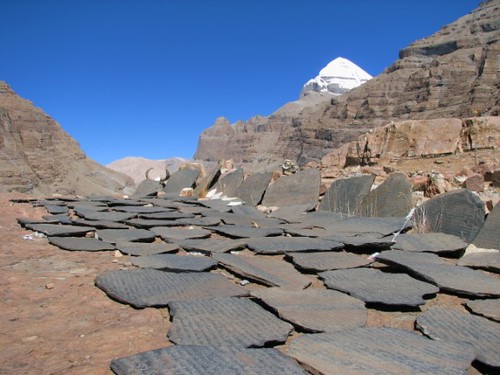
Stone tablets at the Vajrayogini sky-burial ground during the 2nd kora
We decided to take our time on this Kora and soak up the atmosphere a little more. The first Gompa in the western valley was our pad for the first night, breaking up the journey and allowing us to check the place out.
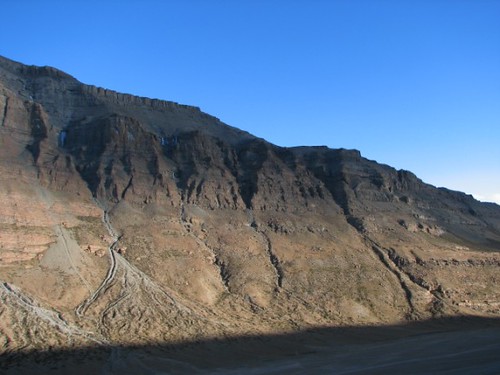 Afternoon light on the 16 Arhats
Afternoon light on the 16 Arhats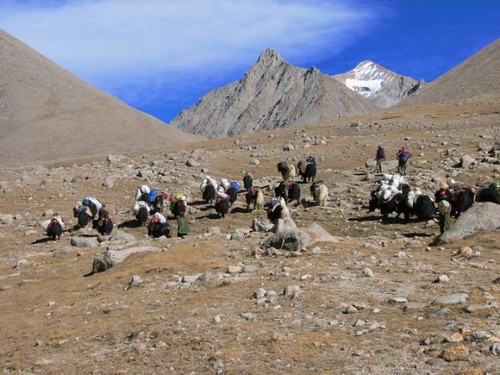 A fleet of yaks loaded up for an group of westerners
A fleet of yaks loaded up for an group of westerners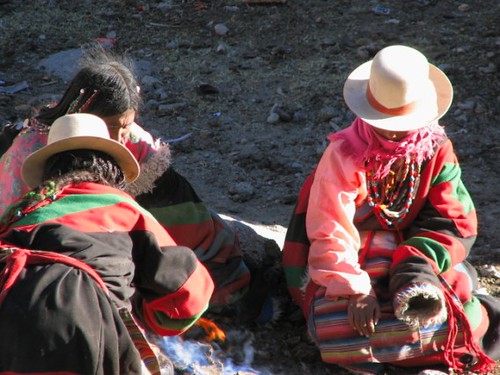
Pilgrims resting after a hard day on the trail
On the second morning we came across a little life-and-death in the mountains scene. A golden Marmot was being hounded by a hound, and was surely bound to be a dogs breakfast very soon. We chased the doggy away, understanding his situation, but empathising a little more with the Marmot whose life was on the line. Mr Marmot was freaking - shaking and quivering with fear, lathered up, teeth exposed, eyes wild and frozen to the spot. I tried to (carefully) encourage him to think about going back to the safety of his burrow, out of range of the doggies canines. The doggy, looking very innocent, slinked off into the sun to watch the stick-waving injie antics. The Marmots post-fight-flight trauma was pretty intense and it took about 10 minutes of us standing guard, before he relaxed enough to stop pretending to be a statue and move to go underground.
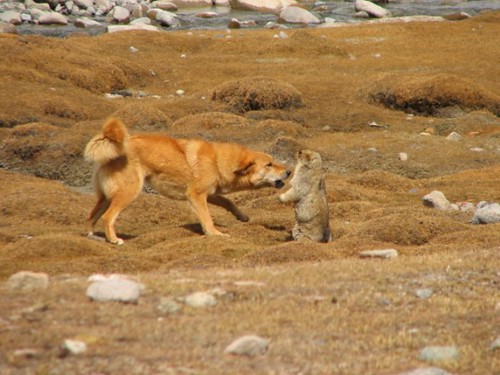 The marmot that was nearly a dogs breakfast - literally
The marmot that was nearly a dogs breakfast - literally Afternoon light on the roof of Drirapuk gompa
Afternoon light on the roof of Drirapuk gompa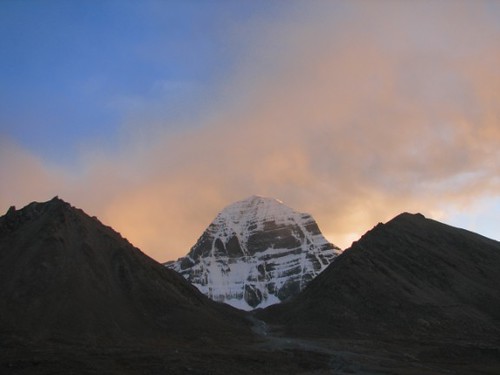
Sunset on the north face of Mt Kailash
On the second day we had heaps more time, allowing us to do an afternoon walk up the small valley towards the astounding north face of Kailash. Prayer filled steps and deliriously happy to get there, we sat contemplating the magnetic vastness and power of the place - which seems to draw you in to a space of silence and reverence. We placed an object given to us by one of our teachers at a small stone meditation hut there, thankful for all out teachers, past and present.
I found myself flabbergasted by someone’s beer bottle blasphemy, wondering how is it possible for someone to bring it there full, here of all places, and then not take it out empty? Astounded. Though this is fantastic example of how the mind is continually joining the dots and adding its own meaning to things. It is entirely possible that this beer bottle had been lovingly carried there by some 'rough as yak-guts' nomad who wanted to make an offering of beer to the stupa in the northern valley (Tibetans do like their beer!). It is also possible that they then thought that the bottle was so lovely that they would leave it there as an offering also. Improbable perhaps, but entirely possible. Would i have been flabbergasted and sitting in judgement then??
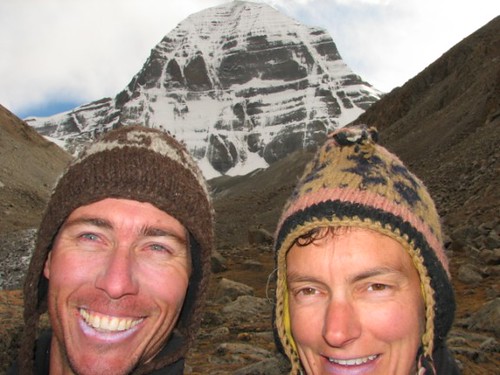 Anna and Scott goofing near the north face under the influence of extreme altitude
Anna and Scott goofing near the north face under the influence of extreme altitude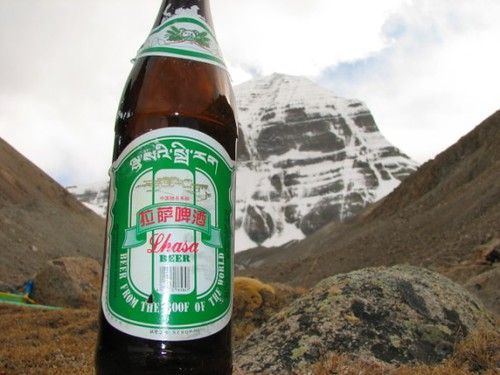
Beer from the roof of the world indeed. How is it that someone could carry this in full, but not take it back out empty?? Flabbergasted,.....
That night a full moon burst over the ridge at about 8 pm and lit up Kailash and the chortens in the surrounding valley. Silence; starlight; still, cold air in a hushed spectacle of beauty. A Japanese fella who had been staying in the dorm with us set of to do the Drolma-la by full-moon light - without a torch. Full power to him!
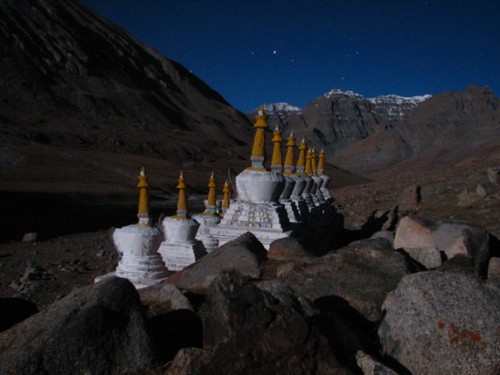 Moon and starlit Chortens in the Drirapuk valley
Moon and starlit Chortens in the Drirapuk valley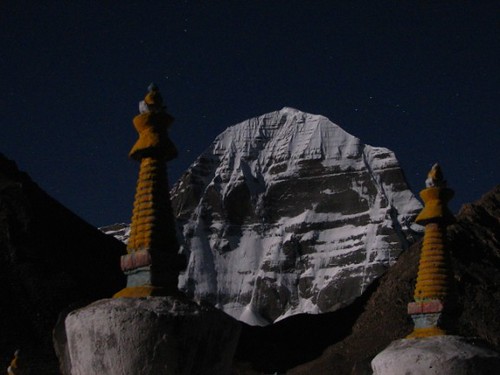 The north face of Mt Kailash under the light of a full moon
The north face of Mt Kailash under the light of a full moon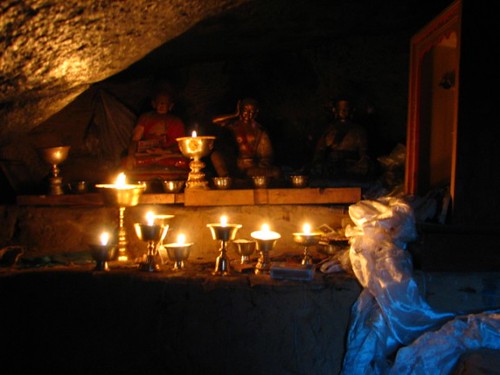
Milarepa and friends in a meditation cave at the back of Drirapuk gompa
The following day we decided to get an early start for the Drolma-la. It was bloody cold hey! I remember washing the Tsampa out of my bowl near a stream, feeling my fingers disappear from the world of sensation, and between putting it down, opening my pack zip and then picking it up again (maybe 5 to 8 seconds) the residual water on the inside of the bowl had fully frozen.
Given all the rubbish i had seen to date, both in Darchen and on the Kora, i decided to stop whining and get pro-active. There where stacks of D-sized Chinese batteries alongside the Kora trail, most containing some mercury, which is nasty for soils but totally disastrous for aquatic organisms. So i decided to gather as many as i could manage (~4kg) and put them in a hole back at Darchen. I questioned my sanity for this decision more than once on the way to the Drolma-la. When i did the calculations to figure out how much mercury this had removed from the Kora it worked out to be about one whole gram! Gotta laugh! And yet i know that many small actions add up. Unless all of us take some small degree of personal responsibility for this earths care, we will all be burnt-toast - along with countless other creatures.
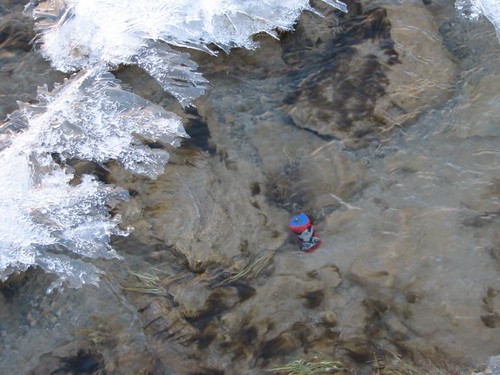 Mercury laden batteries discarded on the kora trail and streams
Mercury laden batteries discarded on the kora trail and streams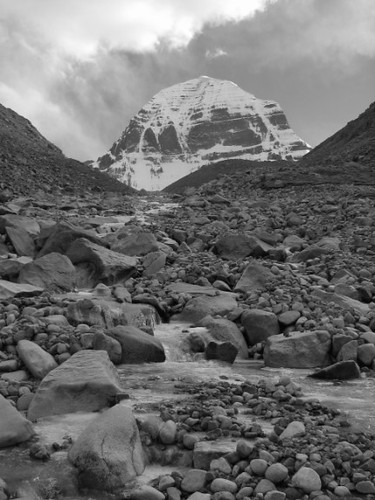 The north face, again
The north face, againGiven that we had intended to take it slow on this Kora, it was interesting that the third day turned into a 12 hr, 32 km epic. We decided to skip staying at the third gompa - the lure of a decent meal in Darchen was too much, so we kept going till the sun went down, Anna on a Red-bull!
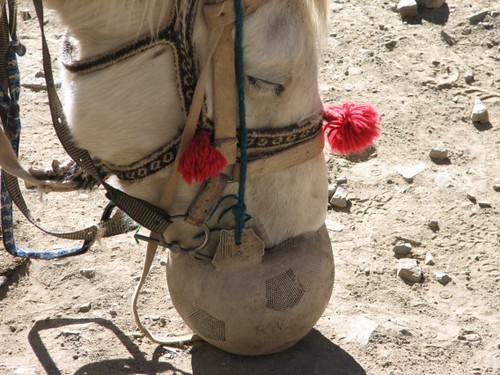
Different bodies, different worlds. To a world cup fan, an object of veneration; to this horse, a tucker box
After a day in Darchen we knew we were ready to go. There was a strong feeling of having completed what we had set out to do. Arranging transport out was another matter. We needed to go east, towards Shigatse, Lhasa, Nepal and the rising of the sun, but there is no public transport that does the 500 km leg to Saga - the next place where public transport can be accessed on the southern route. An alternative northen route was possible, but it was over three times the distance and several days and nights on another sleeper bus. Best avoided if possible. So began the hunt for lifts.
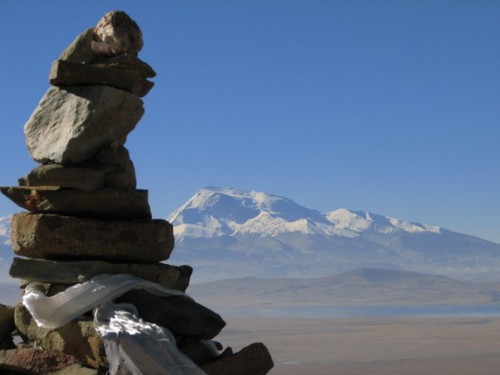
The Barkhor plain, Gurla Mandhata and Lake Rakash Tal from the hills behind Darchen
Most of the available transport was very flash 4WD jeeps. Spare jeeps with bored, chain-smoking drivers, whose cargo of westerners were currently on Kora, were willing to take us to Saga - for a price. Trying to organise and align other budget, independant travellers also wanting to go the same way to share a jeep was a little tricky. Certainly none of the western groups themselves (even those with plenty of room) seemed interested in a couple of paying passengers. The brand new, very shiny, Japanese 4WD's that abound in the TAR (a direct result of injie tour groups paying exhorbitant prices for transport) have lots of passenger room, but the injies who pay are not so keen on sharing it apparently. Fair enough.
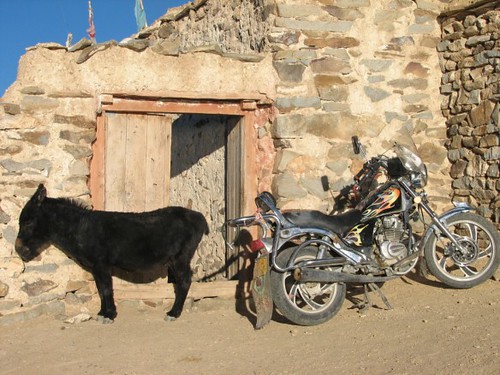
Old Donkey, new Donkey in western TAR
Reviewing Chinese policy on tourism in the TAR reveals they are not keen on independant, budget travellers for several reasons. Mostly because they don't make much money out of them and secondly, i suspect, because such travellers have shown themseleves to be a little harder to control and more likely to be a pain in the arse for the Communist party (ie. 1989 uprising in Lhasa) and also are more likely to be semi-informed about the situation in Chinese occupied Tibet. Hence, making alternative modes of transport for westerners either unattractive or unavailable is unofficial policy and a very effective means of channeling, controlling and herding tourists.
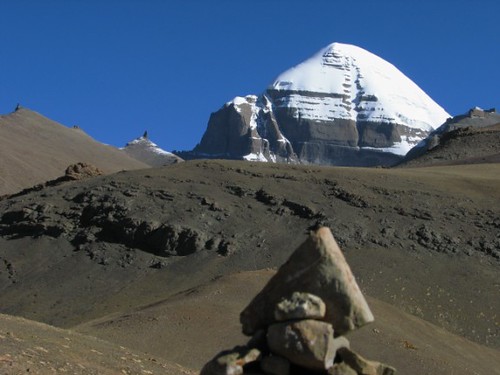
View of the South face from hills behind Darchen
One sunny afternoon, whilst hunting about for alternative transport possibilities, we saw a bus come lumbering up the hill towards Darchen, dust plume trailing behind. We both said "Thats us!" and decended on it in a flurry as soon as its doors opened. The uninterested and uncooperative driver seemed to communicate that it was bound for Saga (amazing!), so we dashed back to our pad and packed as quick as we could. One of our local contacts informed us that this was actually a hire bus and was indeed going towards Saga. Apparently the police had banned a bunch of Tibetan pilgrims from using a truck to transport them home and so thay had to hire a bus instead.
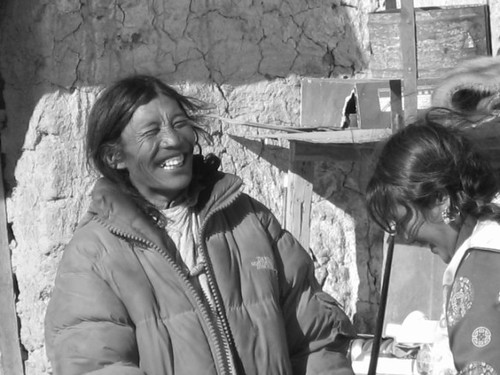
A happy Nomad, winning at a game of snooker
Rocking up to the pilgrim bus, it was already loaded to the hilt and rupturing with smiling, butter-reeking Tibetans, every seat most definitely taken. We didn't care, we wanted out of Darchen. I pleaded and grovelled in broken Tibetan, sending a huge Ama-la (elderly Tibetan woman) into rollicking fits of laughter. This was a good sign, but it was up to the Chinese driver. He initially quoted us an outrageous price (we could have got a jeep for less than that!) and then dropped to almost 1/2 as we began to walk away. Packs were quickly lashed with a long kata on the roof to a bulging pile of luggage and animal hides. We were squished into the spare drivers bed space, noses virtually pressed to the front windscreen and suddenly the bus was moving. Yeehah!!
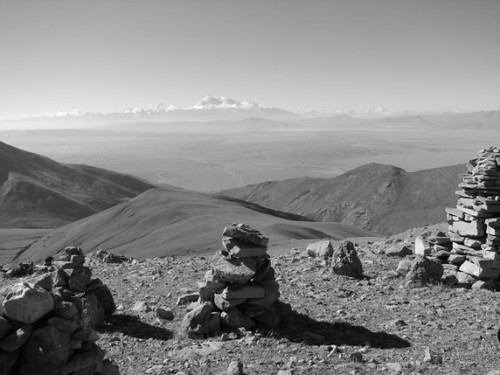
The Barkhor plain and vast open spaces
We had managed to grab some tucker just before leaving Darchen which we then proceeded to eat - rice and vegetables out of a plastic bag, with chopsticks, on a corrugated judder-bar dirt road for the next 30 km. An entertaining hoot and a highly recommended activity! Down at the main road we saw the forlorn figure of one of our friends, an Isreali woman, who had been hitching solo by the road all day, jeeps with injies and space whizzing by, but none stopping. We got the bus to stop and she piled in with us on the spare drivers bed. Bound for Saga. Propped upright against the window and not a wink of sleep for 12 hrs, but honestly very, very happy.
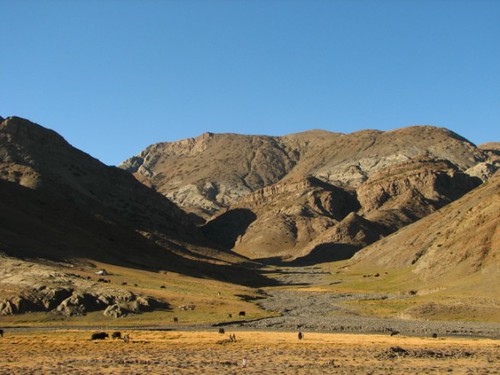
Hills and bare mountains on the way to Shigatse
At about 5am we turned off a side track, then across a river which led us to a dark and empty little village. The entire bus got out at this point - this was their village and the whole town had gone on pilgrimage togther! So it was just us three and the two drivers left as we got out to the main road, when the Chinese power games started. The driver faced the bus back the way we had come, towards Darchen, stopped it and then asked us to hand over the agreed price, or else he wouldn't take us to Saga. We were not in a good position - middle of nowhere, 5am, sub-zero outside - we had only one card and we were not about to dish it over. We had no guarentee at all that once given the money they would actually take us there. Given previous dealings with transport guys this was highly dubious.
At first it seemed like he was having a bit of a half-arsed power game with us, but once he climbed the tree he couldn't back down - the Asian 'face' thing. So he kept pressuring and we kept saying "No, we hand over all the money when we get to Saga" "No Saga, no money" etc - this is standard operating proceedure and he knew it. The pressure kept mounting. Only threats that we would get off the bus, here and now, and give them nothing at all plus a bit of an intervention from the co-driver, who was more level headed, turned the bus around and got us to Saga, where we happily dished up the cash. Pointless stupidity and time wasting power tripping with the injies. But there was more of that to come in Shigatse.
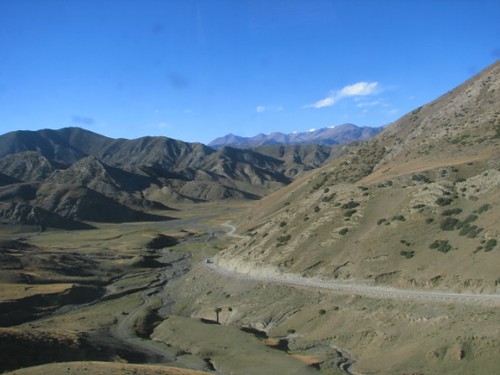
Road to Shigatse
Seven am in Saga is not pretty, but its amazing how a coffee can brighten things a little! The bland uniformity of street fronts in Chinese towns is mind-numbing - a reflection perhaps of communist notions of bare functionality and standardised thinking? Creative individuality not so hot on the agenda.
Another bus was spotted driving around town in the dawn half-light, beeping the horn like a maniac, searching for passengers. It was bound for Shigatse and had other injies on board. In a flash we were on it to - and then we drove around town for another hour and a half, beeping the horn some more (!), until capacity was reached.
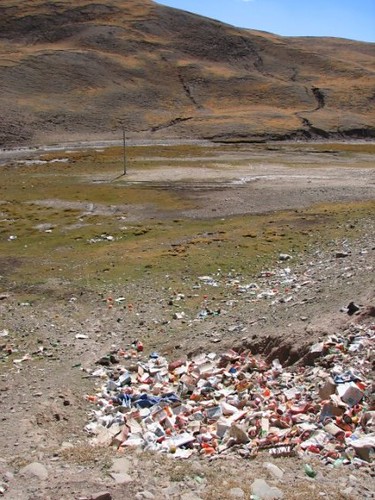 Rubbish in a western Tibetan roadside town
Rubbish in a western Tibetan roadside townThe landscape we drove through during that day was bare, brown hills with twisted and folded strata exposed. It was heavily overgrazed with large erosion scars and interspersed every so often by grotty little roadside towns with the mandatory halo of rubbish. So, 28 hrs after leaving Darchen, we rolled into Shigatse, bum-weary and bone-tired and well off Chinese chain-smokers!
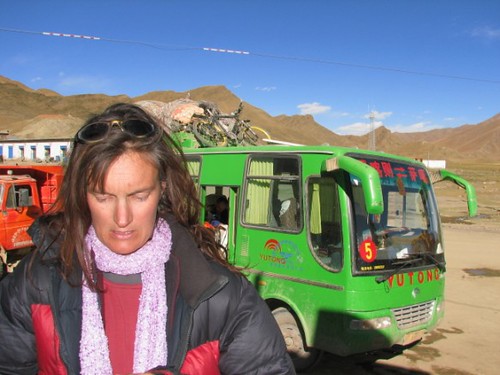
A brief stop on the way to Shigatse
(We caught up with Mark a couple of days ago in Kathmandu. His hitching journey from Darchen to Lhasa was a 5 day epic that made our 'escape' seem very tame. Marks journey in his own words below!)
From Mark:
"Apparently, there’s definitely no bus from Darchen to Lhasa. So, 8:30am, 2 degrees C at best, found me out and walking up the road toward the town of Barga, at the foot of the Lake, 35kms away from Darchen. In an hour i was toasty in a truck cabin. Another 45 mins found me strapping on my pack at Barga, and another literally 45 seconds found me staring at...Everest (the friendly Tibetan who was the guide of the second Swiss crew we had met on route to Darchen) and the empty Pajero 4WD as they gravel-skidded to a halt beside me, agape. Ahhhh....on my way towards Lhasa! They took me all the way to Zhongbao.
Then the Swiss behemoth vehicles had a breakdown, meaning a 3 hr wait. A bus to Saga, the next main town, from where one can apparently bus to Lhasa, rolled up, unannounced. It’s all getting weird! Well, 30 mins later it took off, filled by workers paid for by a boss to get to Saga. D'oh. An obstacle. Still, Everest was still heading for Saga, though the Swiss behemoths were going a pitiful average of 25kms an hour. Not ideal, but I’m not complaining. Still, i see hrs dragging by somehow unnaturally (to my mind)...
So, ok, we go with Everest- it’s been solid till now. Should mention that since the bus from Zhada, where i sat behind a Chinese tourist from Shanghai called 'Dam', Dam has been with Everest. so that’s the 'we'. Dam and me. The Swiss snails decide 73 kms is enough for today. ughhhh!! (don’t get me wrong- they are all lovely and kind) in a town called...dunno, its too small, i sit in a teahouse, Dam outside. I spy a new 4wd, Dam sidles up, i jump out to it, and it’s a thumbs up after a Chinese back-and-forth. You beauty!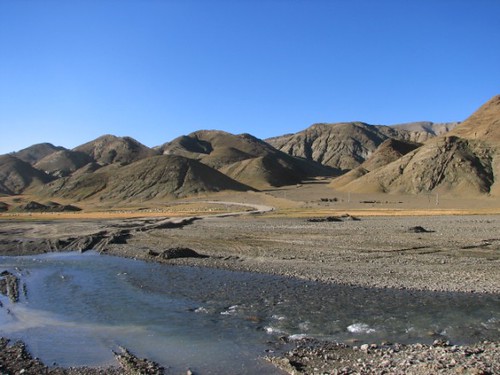
Mountains on the way to Shigatse
We got a ride to Saga (how appropriate!) for 30 yuan each, 2hrs. Good deal. So, here i am in Saga. The idea was to get the 20-seater public bus, tickets available in the shop next to our guesthouse, to Lahtse, visit the gompa there, then on to Lhasa. Well, that’s where the almighty spanner of karma fell in the works! They will NOT take foreigners on that bus [note from Scott: yet with typical indecipherable inconsistency, several days later Anna and I and a whole bunch of injies get the public bus from Saga, no problem(??)]. Why? Order of police. No reason.
Until now, the police have been non-existent, other than to actually happily help us once at Darchen with no fuss. So, it seems impossible to get a ride on public transport from here. The go is that there is a checkpoint 2 kms out of town, which fines bus drivers for taking foreigners. So, the plan is to walk the 2 kms, pass through the checkpoint alone on foot, and then another km or so and flag down a ride. Next problem is the checkpoint at Lhatse. They are supposed to be tougher than Saga. So, if i get a lift, i hop out one km or so before the checkpoint, waltz through (ha!), and get a legal bus to Sakya, lap up the ancient warmth of early Buddhist monasteries, wonder at how anyone could actually stand there and smash it to pieces as the communist Chinese did for 10 years of the cultural revolution, pray some more, and land in Lhasa the next day, via a gorgeous and eagerly awaited PAVED road!!! Cant wait for that!
[after arriving in Lhasa]
G’day from Lhasa. Got here 3 days ago. The trip from saga was a shocker/ripper, depending. No buses would take foreigners, as I said, so I walked out past the police checkpoint. Walked about 5 kms before resting. Then got a tractor ride for 5 kms. Tantalizing, but not quite in Lhasa. Yet. Walked another few kms, then a lone Tibetan in 4WD picked me up for 13 kms. Nearly halfway to Daoban (road crew station) 22 where the northern road from Ali - with extra traffic - meets the southern road which I was on, from Ali via Kailash.
Walked another 7kms, before getting totally despondent. Hadn’t seen one vehicle for 3 hrs. Sat down to eat stale bread and vegemite, and a little vehicle came by, and kept going! Argh. Eventually a China post truck came and I squeezed in half crouching and balancing against the window, seat back and other passengers for 25 excruciating kms, up over a pass, and down to Daoban 22. Phew, glad to have caught that one. The walk was high, winding and long. Many trucks and 4WDs passed through the Daoban - none interested in me - until a land cruiser with 2 Tibetans came in, having finished a group tour, on their way back to Lhasa! You beauty!!!
They agreed to 150yuan for the ride to Lhatse, from where I wanted to visit Sakya before heading to Lhasa. Night fell, the pace was good, and they pressed on. These were my kind of guys, just balling through the night grimly and steadily until we got there. Hmmmmm. That’s when the wheels started falling off,....
For those who have any sense of comedy/tragedy, you will know I mean that literally. At about 10pm, on some unknown road in the middle of a plain, the front right wheel overtook us as we landed with a scratching thud on the rim. It ended up about 30 metres ahead of the vehicle in a ditch. Not to be deterred, and without a grumble or a missed beat, the 2 Tibetans were immediately out and into it with tools, after much laughter and sheepish looks. At this point, I also found it funny.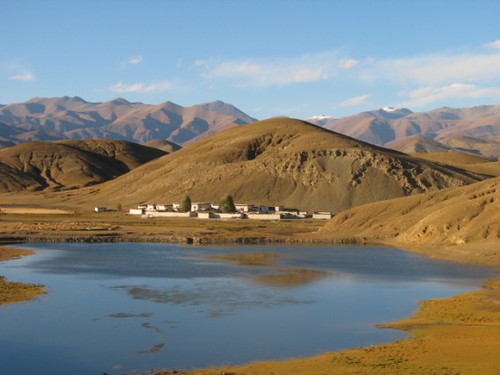
Village by a little lake
Fifteen hours later (!!) - the shelf life of humor in such situations is highly volatile. Anyway, they started reshaping the rim with rocks and pliers, picking up the pieces of shattered brakes and assorted wheel bits, and somehow managed to reaffix the wheel. We got about 25 metres before it came off again. It was 2:30am and time for a cramped, cold and frustrated “sleep”. Sunrise saw the uncomplaining driver out with his rocks and tools and infinite patience (he knows he can fix anything) 3 hrs later, we crawl another 100 metres, just far enough to get to the top of a rise, and for the bloody wheel to fall off again. Uggghhhh.
Traffic halted to watch the proceedings, and 30 minutes later, we try again. 50 metres and that was it, grinding and slewing, we pull over into a ditch for serious considerations. An hour of fruitless toil saw the driver head off in a passing truck, 15kms to the nearest town for parts and the other guy and me consigned to instant noodles and prayers. It had all turned to crap. I saw my “picking up a day” evaporate into “losing a day”, and there was nothing at all I could do. The one positive I could see was the opportunity to watch my mind and see what reactions were coming up. That got real ugly, real quick, so switched off. That worked for about a minute.
After 2 more hours and no sign of the driver and his new set of wheel bearings and axle grease, and a steady stream of non-compliant Chinese in 4WD’s, a lone foreigner happened by in a land cruiser. Just one - lapping it up by himself in the back, a near empty boot, and they stopped. My prayers are answered, watching my mind go from despair to joy, up and down, up and down. My “Hi I’m hitching with these guys, but they’re really stuffed”, was interjected with (in the most annoying syrupy American accent- well, any accent would have peed me off at this point) “Oh I’m sorry, I’m not taking any riders”!!!!!.
I’m maintained face and calm, for about 30 seconds, long enough for him to be out of harms way. Then I started to fall apart. All sorts of negative aggressive and self pitying thoughts raged through my mind. Every car that passed now became an object of hatred. I was seeing red. I couldn’t believe how quickly and easily I lost my patience, and I was aware of it as it happened, knowing I was somehow ‘failing’, as only one can given ones limitations. Tired, cold, hungry, losing precious ‘time’, I felt all the conditions were against me. What a turn! I did lose my perspective for a little while. Old habits.
Anyway, the driver arrived with everything he needed, and after 90 minutes we were really on our way. We limped into town, got something welded to the wheel, and headed off for Lhatse - at 30 kms per hour. Aaaaaaaaaaaaargggggggggggggghhhhhhhhhhhhhhhhhhh! Well, what to do?! I calculated that I could get to Sakya that night, just beating sunset, and still be on my original schedule to make it to Everest base camp and then Nepal by the 22nd. Of course, the trip took an hour longer than I foresaw, and we rolled into a guesthouse in Lhatse, an agonizing 25 kms short of Sakya. That meant a lost night, and decisions to be made. Fuming, I went to bed intending to hitch to Sakya at sunrise. The sun rose, but the ride did not. I let go of Sakya and found a bus departing in half-hour for Shigatse, 2 hrs away, and 5 hrs shy of Lhasa. Done.
Sakya was cut, and I was speeding on a beautiful asphalt highway, at least 80 wonderful kilometers per hour. I noticed how the currency had been changing since I left Nepal August 2. Trekking it was chocolate bars, water, and iodine for purifying it. Traveling up the Karakoram it was vegetables. Hitching on a schedule (mutually exclusive) it was hours and kilometers. All my own mind, my own desires and calculations and grasping. I loved the driver- I even found humor for his ear shattering appalling Chinese opera music, even the chain-smoking buffoons escaped wrath. I was flying towards Lhasa and happiness. Hehehehe. Still haven’t learned a thing it seems!
And then, it happened. Or rather, didn’t happen. The engine I mean. It just stopped. No water. A cooking motor, temperature rising, mine too. What idiots! Arrrgh, my latest best-friend was now a despised enemy. He was in the way of my happiness! Sigh. Time for more reflection. We finally got going somehow and rolled into Shigatse, home of the Tashilhunpo, seat of the Panchen Lama. The Panchen are the 2nd highest lama’s behind the Dalai’s, and the current has been under house arrest by the Chinese since he was about 4 years old. The commie Chinese have declared their own Panchen, in the hope of manipulating the religious/political scene. Seriously, house arrest since 4, and unheard of since. They wont let anyone know where he is, let alone talk to him. Shigatse has not much else going for it these days.
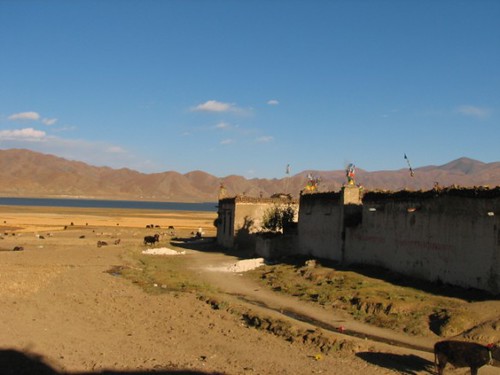
Tibetan houses
Luckily the bus to Lhasa left in half an hour. So I was again speeding my way to Lhasa, happy again, worn out mostly from the mental rollercoaster, but still happy and excited to be on the way. I started recognizing things from my first trip in 2002, and then, I started not recognizing. As we approached Lhasa, things started looking weird. There were now housing development projects rising up, a bridge, huge billboards showing monks and mobile phones, traffic lights, bulldozers etc etc etc. all the trappings of a rapid development of an outlying area with obvious designs underneath it all. Scary, ugly, bemusing, sad.
So now I sit, showered, well fed, too well, having visited the Jokhang temple, and just now the Potala. I shed tears from the ends of the spectrum today. Joy at the Jokhang, sadness isn’t the word at the Potala. What they have done there is appalling. The whole bloody thing is appalling. Again, watching the mind. All kinds of things came up for me around the visits today. But the sight of 3 old Tibetan ladies prostrating from the gutter in the wide tiled road in front of the Potala, behind them a huge flagpole with bright red Chinese flag flowing in the square where there used to be a fighter jet parked in full view (now removed) was too much.
After having just wandered through the museum that this magnificent edifice now is, having been denied access to so many wonderful rooms and chapels, even denied to walk around a huge triple Mandala that I went round 4 years ago, with the Tibetan staff shaking heads saying ‘Chinese police, Chinese police’ and making fearful faces at my request to walk around the otherwise open concourse of about 20 metres, and seeing Chinese police in crisp uniforms with crackling walkie talkies, laughing loudly and stalking officiously (here goes my mind again) around as if they bloody owned the place!!
So Lhasa here has me in a state of highly volatile and very, very mixed emotions. Scott and Anna had reservations about coming here, for their own reasons, but I’m adamant. You’ve gotta go. Even his Holiness has said that as many people as possible should come, and go tell people about it. Oh that nasty ‘splittist’! So here I am fulfilling my teachers¡¯ wishes. Ok, I don’t hate the Chinese. They are suffering, and causing more and more suffering all around them, and will have to experience the results in the future. So the Buddhist response is to see this and have compassion. I’m still trying. But I do hate, and that’s even going too far, the rigid and closed mind that creates all these horrid situations. I guess its cos’ it reflects rigidity and closed-ness in my own mind stream that I have yet to integrate and accept. Anyhow, I see how this whole pilgrimage has been a constant flow, at least I have more of a sense of that now, and also a strong sense of that in my life, eschewing destinations, ‘ends’, and just flowing, seeing, learning, opening."
One wedding, several Koras and a very long way,......continued
Skip to Part 1
Skip to Part 2
Skip to Part 4



<< Home